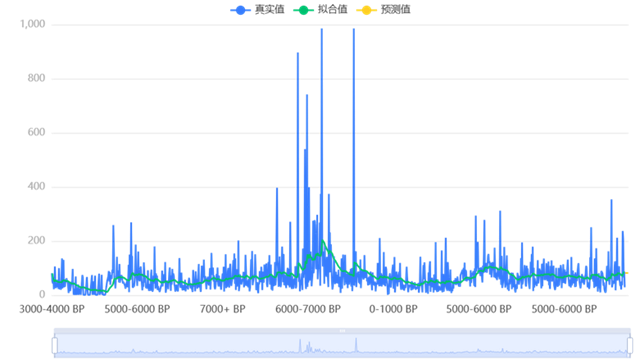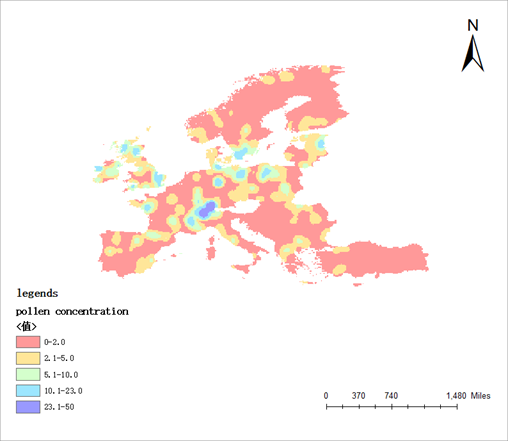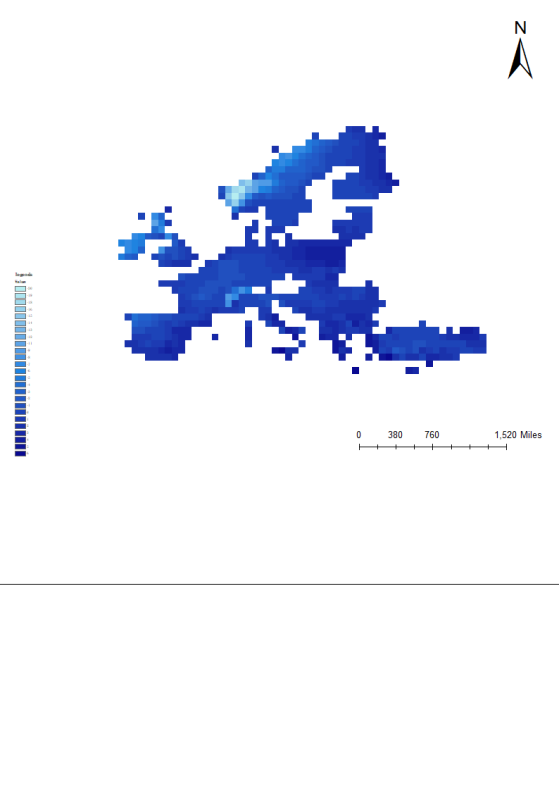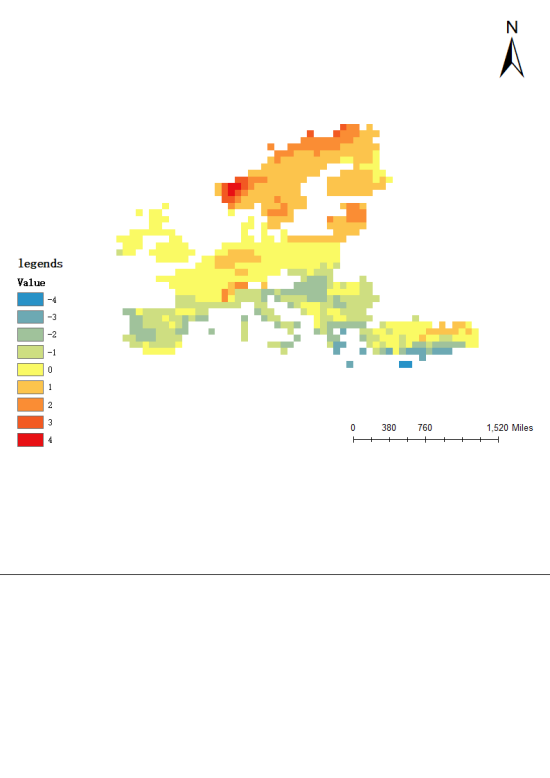1. Introduction
The Holocene is a pivotal climatic period in Earth's history that began about 11,700 years ago and continues to the present day. It witnessed significant climatic changes, including the transition from ice ages to interglacials, and subsequent climatic fluctuations. These climatic changes have had a profound impact on global vegetation patterns, which in turn have had important implications for the development of ecosystems and human civilization. The study of vegetation response to climate change during the Holocene can provide an important historical background and scientific basis for our understanding of ecosystem responses under future climate change. Pollen analysis, as an important method for reconstructing paleoclimate and paleoenvironment, can provide information about past vegetation and climate change. By studying pollen concentrations at different periods, it is possible to preliminarily explore the relationship between these influencing factors and vegetation. In this study, we explore the response of vegetation to climate change by analyzing pollen data with temperature and precipitation data during the Holocene in the European region using SPSS and ArcGIS.
Vegetation changes in different European country regions during the Holocene period have long been studied by scholars. For example, Collins et al.2012 found that during the mid-Holocene, southern Europe was more heavily forested with temperate vegetation than it is at present, but drought-tolerant xeric vegetation was still widespread along the southern margins of the region[1]. In the western Mediterranean region, between an early Holocene period characterized by cooler and moister conditions than at present, favorable to temperate deciduous trees, and, after 5000 yr BP, a later Holocene period with a warmer and drier climate[2].However, there are fewer studies for Europe as a whole, so we hope to combine our preliminary analyses with the existing literature to initially explore the response relationship between Holocene vegetation and climate in Europe. This study aims to reveal the impact of climate change on European vegetation during the Holocene through multidimensional data analysis.
2. Literature Review
The following explores how plant species in Europe responded to climatic and anthropogenic changes over the Holocene epoch. The analysis divides into three periods: Early Holocene, Mid Holocene, and Late Holocene, focusing on what the climatic impacts and anthropogenic influences were during the given period. Starting with the Early Holocene that extended from 11.7 to 8.2 ka, this was when the cooling event and abrupt climate change at 8.2 ka exerted a broad impact on the vegetation of Europe. Both pollen and macrofossil records suggest the immediate and strong vegetational changes. Tinner and Lotter present the evidence for the sharp decline of Corylus avellana (hazel) of Central Europe along with rapid expansion of Pinus (pine), Betula (birch) and Tilia (linden). This reorganization alludes to the fact that "climatic cooling reduced drought stress favoring drought-sensitive species that outcompeted hazel"[3]. Further macrofossil evidence from northern Europe suggests that early Holocene summer temperatures were approximately 2°C warmer than later periods leading to the northward migration of temperate species and retreat of cold-adapted flora[4]. Although the anthropogenic impacts during this period were not as significant as climate due to small populations, Edwards et al. noted the possible Mesolithic human impact on vegetation, through the noting of reductions in local woodland due to anthropogenic fires in the Early Holocene[5].
The Mid Holocene lasting from around 8.2 to 4.2 ka faced a major climatic event that further impacted vegetation dynamics. This was demonstrated by Li et al. using models, where the cooling event caused differential impacts across Europe, with more pronounced vegetation responses in the north due to greater climatic sensitivity and species close to the edge of their climatic tolerance[6]. Transitioning from climatic impacts to anthropogenic influences during the mid-Holocene, onset of early agriculture around 7000-6500 BP began to affect vegetation in Europe quite markedly, though with climate still exerting a dominant role. Then more significant changes initiated from 4500-4000 BP with the increase in agricultural intensity; land use already had a more substantial impact on vegetation dynamics in four key phases: initial expansion of agriculture, intensification of agricultural practices, wide deforestation, and development of permanent settlements[7].
The Late Holocene stretching from 4.2 ka up to today saw never-ending climatic fluctuations, with a major impact on vegetation dynamics. Huntley documented compositional changes of European forests, reporting that changes in the dominant tree species—decline of Pinus (pine) and Betula (birch), and rise of Fagus (beech) and Quercus (oak)—had direct relationships with climatic variations. Various trends occurred in different regions; for instance, the drop in summer temperatures in northern Europe led to dominance by cold-tolerant species, while the Mediterranean region witnessed increased summer temperatures that promoted drought-resistant species[8]. Thuiller et al. predicted that the majority of species, with a bias towards those located in the mountains and at northern latitudes, would be sensitive to the described climatic changes during the late 21st century because the change in temperature and precipitation may alter the climate envelope and thus reduce the available habitat area for cold-adapted and high-altitude species[9]. In the Late Holocene, anthropogenic activities accelerated vegetation changes. Marquer et al. reveal that 500–350 BP, new agricultural methods, industrialisation practices among others ushered in significant changes in the vegetation cover, such as extensive clearance of forest for agriculture, introduction of non-native species, change in land use patterns with a clear anthropogenic signature in the post LIG period[7].
All in all, in the Holocene, European plant responses to climatic and anthropogenic changes were strong and diverse from one time period to another. Other key climatic events recorded during the Early and Mid Holocene apparently triggered a change in vegetation dynamics, with accelerated changes driven by human activity taking place in the Late Holocene. Knowledge on these responses might help in understanding the way contemporary and future climate changes continue to impact European ecosystems.
Climatic factors and anthropogenic factors are always considered together by researchers while exploring vegetation changes. At first, Seddon et al. suggests that there was a strong linear relationship between pollen assemblage turnover and large directional temperature changes during the abrupt climate changes of the Lateglacial–early Holocene transition by using the European Pollen Database (EPD), indicating the dominance of climate change on affecting vegetation cover in Europe during the early Holocene. However, the vegetation response was non-linear and highly variable across and between regions during the dispersal of early modern humans (EMH) into Europe[10], which raised the awareness that anthropogenic factors also played a crucial role in vegetation changes in Europe during the Holocene. To investigate the relative importance between climatic factors and anthropogenic factors on vegetation change, Marquer et al.2017 identified four critical phases of land-use effects on vegetation from pollen-based REVEALS estimates. From the first phase (from 7000–6500 BP), which corresponds to the early impacts on vegetation of farming and Neolithic forest clearance, to the last phase (from 500–350 BP) formed by new farming practices and forestry in response to population growth and industrialization, the importance of anthropogenic impact gradually increased while the importance of climatic impact accordingly decreased[7]. The shifts in areas of abundance and dominance also indicated the major effects of Late Holocene anthropogenic land use practices in Europe in combination with climate change on vegetation changes using EPD[11]. Although the vegetation response in late Holocene was mainly mediated by intrinsic factors, climate is the major driver of vegetation when the Holocene is considered as a whole.
3. Scientific Rationale
3.1. Importance of Climate
Changes in temperature, precipitation patterns, and sea levels can affect the habitats available for plants, leading to shifts in their distribution and diversity. For example, during periods of glaciation, many plants may have been forced to migrate to more temperate regions, leading to a decrease in diversity in some areas and an increase in others. Additionally, changes in climate can also lead to the extinction of certain plant species that are not able to adapt to the new conditions, further affecting the overall diversity of vegetation. In essence, ancient climate can have a profound impact on the distribution and diversity of vegetation through its effects on habitat availability and the ability of plants to adapt to changing conditions.
3.2. Holocene Climate Impacts
There were several significant climate changes in Europe during the Holocene and ones with the most significant impacts on vegetation are listed below[12].
(1. The Holocene climatic optimum: Approximately 6,000 to 8,000 years ago, Europe experienced a period of increased temperatures and precipitation, leading to the expansion of forests and the spread of tree species such as oak and elm. This period also saw the development of peat bogs in areas such as Ireland and Scandinavia.
(2. The Little Ice Age: From around the 14th to the 19th century, Europe experienced a period of colder temperatures and more extreme weather events, resulting in the retreat of forests and the expansion of grasslands and shrublands. This period had a significant impact on agriculture and human populations in Europe.
(3. The Medieval Warm Period: Between the 10th and 14th centuries, Europe experienced a period of warmer temperatures, resulting in the expansion of forests and the spread of tree species such as beech and pine. This period also saw the development of more diverse ecosystems and the colonization of previously uninhabited areas.
3.3. Research Significance
Paleoclimate and vegetation research is of significant importance as it helps in understanding past climate-plant relationships, which can then be used to inform future predictions about how plant species will respond to changing environmental conditions. By identifying the mechanisms underlying plant species responses to past climates, researchers can gain insights into how plants may adapt or shift their distributions in the face of future climate change. Additionally, this research aids in improving our understanding of regional-scale climate-plant dynamics, which is crucial for effectively managing and conserving ecosystems in the coming decades.
4. Data and Methodology
4.1. Data Sources
This paper uses pollen data from A full Holocene record of transient gridded vegetation cover in Europe from Pangaea, climate data from AGU's Greenland-Wide Seasonal Temperatures During the Last Deglaciation, and in particular a set of climate data from NOAA's European Holocene Pollen-based Gridded Climate Reconstruction for a period of 6000 years before present for the analysis and visualization of this study, aiming to study the response of Holocene vegetation to the Holocene vegetation response to paleoclimate.
4.2. Methods of Analysis
4.2.1. Time series Analysis
This study uses ARIMA model for time series analysis. ARIMA model is a commonly used time series forecasting method for smooth time series data.
4.2.2. Correlation Analysis
This study analyzed the correlation between four variables: pollen count, mean annual temperature, BIC ice age and GICC05 ice age. The correlation coefficients between the variables and their significance were calculated using spearman correlation analysis.
4.2.3. Kernel Density Analysis
In this study, the kernel density analysis of pollen counts in Europe during the Holocene period demonstrated the spatial distribution of pollen concentration in different regions.
5. Results
5.1. Results Of Time Series Analysis
For the variable “nPollenSamples”, the ADF test is first performed without differencing (order of differencing = 0). The t-statistic obtained is -3.573, which is less than the critical value of -3.436 at a 1% level of significance, thus the series is considered to be smooth at a 1% level of significance. The p-values at difference orders 0, 1, and 2 are significantly less than 0.05, indicating that the variable is smooth at these difference orders. However, the ARIMA model-based forecasting for the next seven periods has a low fit.

Figure 1. Holocene European pollen time series diagram
5.2. Results of Correlation Analysis
Based on the results of Spearman correlation analysis provided, the correlation between the variables and their significance levels can be observed.

Figure 2. Correlation coefficient heat map
First, note that all correlation coefficients are accompanied by significance level markers (***, **, *), representing 1%, 5%, and 10% significance levels, respectively, indicating that all observed correlations are not randomly generated and are statistically significant.
Weaker correlations were observed between the variable pollen sample size and the other three variables. Among them, “nPollenSamples” was negatively correlated (r = -0.114) with “T annual (oC)” and although this correlation was weak, it was highly statistically significant (p < 0.001). In contrast, “nPollenSamples`” was positively correlated (r = 0.212) with both ice age indicators (“BIC Ice Age” and “GICC05 Ice Age‘) and was also highly statistically significant.
5.3. Kernel Density Analysis Results

Figure 3. Kernel density distribution of pollen concentrations in Europe during the Holocene
According to Figure 3, there are significant spatial differences in the distribution of pollen concentration in different parts of Europe. The following points were mainly observed:
1. High-concentration areas: purple and blue areas indicate places with high pollen concentration, mainly distributed in some areas of central and western Europe. The high pollen concentrations in these areas may be related to the dense forest cover and rich plant species.
2. Areas of medium concentration: The cyan areas indicate places with medium pollen concentrations and are more widely distributed, also including some parts of central and western Europe.
3. Low concentration areas: The red and orange areas indicate places with low pollen concentrations, mainly in parts of southern and northern Europe.
5.4. Results of Special Period Analysis
The middle Holocene period, about 6000 years before the present (around 4000 BC), was characterized by a relatively warm climate in Europe and is often referred to as the Holocene Climatic Optimum (HCLO). This period is characterized by significantly higher temperatures than modern levels in several regions of the globe, especially in the mid-latitudes of the Northern Hemisphere. In this paper, we visualize the temperature and precipitation during this period by using ArcGIS to obtain the figure below. Precipitation patterns in the middle Holocene varied regionally. In general, precipitation was high in southern and central Europe, while it was relatively low in northern Europe. At the same time, temperatures were higher in northern Europe and lower in southern Europe.


Figure 4. Precipitation and temperature map of Europe 6000 years ago
6. Discussion
6.1. Discussion of the literature review
• The research papers utilized different pollen-based datasets (REVEALS and EPD), which reduces the bias toward specific type of data source and increases the objectivity of the literature review but also weakens the validity and reliability of the main conclusions due to the potential inconsistencies in different data sets.
• The main conclusion from the literature review that climate is the major driver of vegetation when the Holocene is considered as a whole provides the fundamental scientific rationale for our research question and supports our further analysis of data by only considering climatic factors instead of anthropogenic impacts.
• The literature review clarified the relative significance of land-use and climate impacts on vegetation, but underlined the importance of long-term trends in fully understanding natural- and human-induced variability in land cover, so there need to be more attention to the time dimension in order to aid in biodiversity conservation and ecosystem management and predict future shifts under ongoing climate change[7].
6.2. Discussion of the analysis
• The analysis and visualization used various data sources from Pangaea, AGU and NOAA. We utilized data from different sources without dismissing or favoring any particular source. This reduces the bias toward any kind of data set, which leads to relatively unskewed and complete findings on vegetation responses to climate change, making sure the objectivity and reliability of the research. By combining various pollen data and climate data, we ensured the representativeness of each data set and the validity of the research conclusions. However, there still might be some potential biases when choosing the data sets, selecting analytical tools and visualizing data, which could weaken the validity of our result and its accuracy in a broader phenomenon.
• The time series analysis revealed that the series of nPollenSamples variables is smooth and can be predicted using the ARIMA model. However, the reliability of the prediction results is limited due to the low goodness of fit of the model. In subsequent studies, attempts can be made to introduce more variables or use other prediction models to improve prediction accuracy.
• The results of the correlation analysis showed that there was a significant negative correlation between nPollenSamples and mean annual temperature, which may indicate that an increase in the number of pollen samples may be associated with a decrease in mean annual temperature under certain conditions, but further research is needed to clarify the specific mechanism of this relationship. At the same time, there was a significant positive correlation between the number of pollen samples and the ice age data, which may indicate that the number of pollen samples may increase as the ice age advances or as the age of the ice age increases. This may be related to changes in vegetation types and pollen preservation conditions under ice age conditions. These findings provide new perspectives for understanding the response of Holocene vegetation to paleoclimatic changes.
• Analysis of the spatial distribution of pollen concentration showed that the vegetation and climate of the European regions had a significant effect on pollen concentration. Areas with high pollen concentrations usually have a wetter climate and rich vegetation cover, while areas with low pollen concentrations tend to have a drier climate and sparse vegetation. These results are consistent with studies of climate change and vegetation distribution since the Holocene. Climate is the major driver of vegetation when the Holocene is considered as a whole[7].
• The analysis of spatial distribution of pollen concentration suggests clear responses of vegetation cover to mean annual temperature, ice age, and precipitation respectively, which indicates climate as a main driver of vegetation change, but the extent and proportion of each climatic factor affecting vegetation cover is unclear in this research. Next step for subsequent studies is to clarify the relative importance of each climatic factor in affecting vegetation cover in Europe during the Holocene to provide new insights.
The limitation of this study is that only temperature and precipitation effects on vegetation were observed, whereas there are many specific events such as hill fires and other human activities in Europe during the Holocene period that were not taken into account, and more environmental variables should be integrated in future studies to provide a comprehensive understanding.
7. Conclusion
The Literature review summarizes the ongoing debate on the relative importance between climatic factors and anthropogenic impacts on vegetation changes in Europe during the Holocene and suggests that although anthropogenic impacts became more and more significant in affecting vegetation cover, climate is still the major driver of vegetation when the Holocene is considered as a whole. The finding confirms our research direction on vegetation responses to climate change in Europe during the Holocene and provides support for our further data analysis part. We downloaded pollen data from A full Holocene record of transient gridded vegetation cover in Europe from Pangaea, climate data from AGU's Greenland-Wide Seasonal Temperatures During the Last Deglaciation, and in particular a set of climate data from NOAA's European Holocene Pollen-based Gridded Climate Reconstruction for a period of 6000 years before present to analyze and visualize the vegetation responses to mean annual temperature, ice age and precipitation respectively by using SPSS and ArcGIS. The results suggest that an increase in the number of pollen samples may be associated with a decrease in mean annual temperature under certain conditions. Also, the number of pollen samples may increase as the ice age advances or as the age of the ice age increases. Furthermore, areas with high pollen concentrations usually have a wetter climate and rich vegetation cover, while areas with low pollen concentrations tend to have a drier climate and sparse vegetation. The strong correlation between vegetation cover and climate change proves the main conclusion obtained from the literature review. This research provides new perspectives for understanding the response of Holocene vegetation to paleoclimatic changes.
Author contributions
Xuan Pan(Esther): conceived the initial idea of Data Query, Analysis, Graphing, Analysis of Results, Partial Discussion, Introduction, Abstract and Integration of the Article.
Guangsen Xue (Raymond): Scientific Rationale and Partial Literature Review
Yurui Wang (Andy): provide key references for the paper, write partial Literature Review, partial Discussion and the whole Conclusion part
References
[1]. Collins, P. M., Davis, B. A. S., & Kaplan, J. O. (2012). The mid-Holocene vegetation of the Mediterranean region and southern Europe, and comparison with the present day. Journal of Biogeography, 39(11), 1848-1861.
[2]. Magny, M., Miramont, C., & Sivan, O. (2002). Assessment of the impact of climate and anthropogenic factors on Holocene Mediterranean vegetation in Europe on the basis of palaeohydrological records. Palaeogeography, Palaeoclimatology, Palaeoecology, 186(1-2), 47-59.
[3]. Tinner, W., & Lotter, A. F. (2001). Central European vegetation response to abrupt climate change at 8.2 ka. Geology, 29(6), 551-554.
[4]. Väliranta, M., Blundell, A., Charman, D. J., Karofeld, E., Sillasoo, Ü., & Tuittila, E. S. (2015). Plant macrofossil evidence for the onset of the Holocene summer thermal maximum in northern Europe. The Holocene, 25(1), 134-146.
[5]. Edwards, K., Langdon, P., & Sugden, H. (2007). Separating climatic and possible human impacts in the early Holocene: biotic response around the time of the 8200 cal. yr BP event. Journal of Quaternary Science.
[6]. Li, X., Kaplan, J. O., & Krumhardt, K. M. (2019). Modelling the vegetation response to the 8.2 ka cooling event in Europe. Climate of the Past, 15(5), 1643-1663.
[7]. Marquer, L., Gaillard, M. J., Sugita, S., Poska, A., Trondman, A. K., Mazier, F., Nielsen, A. B., Fyfe, R. M., Jönsson, A. M., Smith, B., Kaplan, J. O., Alenius, T., Birks, H. J. B., Bjune, A. E., Christiansen, J., Dodson, J., Edwards, K. J., Giesecke, T., Herzschuh, U., Kangur, M., Koff, T., Latałowa, M., Lechterbeck, J., Olofsson, J., & Seppä, H. (2017). Quantifying the effects of land use and climate on Holocene vegetation in Europe. Quaternary Science Reviews, 171, 20-37.
[8]. Huntley, B. (1990). European post-glacial forests: compositional changes in response to climatic change. Journal of Vegetation Science, 1(2), 181-188.
[9]. Thuiller, W., Lavorel, S., Araújo, M. B., Sykes, M. T., & Prentice, I. C. (2011). Consequences of climate change on the tree of life in Europe. Nature, 470(7335), 531-534.
[10]. Seddon, A. W., Macias-Fauria, M., & Willis, K. J. (2015). Climate and abrupt vegetation change in Northern Europe since the last deglaciation. The Holocene, 25(1), 25-36.
[11]. Giesecke, T., Brewer, S., Finsinger, W., Leydet, M., & Bradshaw, R. H. (2017). Patterns and dynamics of European vegetation change over the last 15,000 years. Journal of Biogeography, 44(7), 1441-1456.
[12]. Kirchgeorg, T., Wischnewski, J., Heinrich, K., Hall, D., & Plege, J. (2020). Holocene vegetation dynamics and climate variability in the Ore Mountains (Saxony, Germany) revealed by pollen analysis of Merzdorf Bog. Vegetation History and Archaeobotany, 1-14.
Cite this article
Pan,X.;Wang,Y. (2025). Plant Responses to Holocene Climate Change in Europe. Theoretical and Natural Science,78,20-28.
Data availability
The datasets used and/or analyzed during the current study will be available from the authors upon reasonable request.
Disclaimer/Publisher's Note
The statements, opinions and data contained in all publications are solely those of the individual author(s) and contributor(s) and not of EWA Publishing and/or the editor(s). EWA Publishing and/or the editor(s) disclaim responsibility for any injury to people or property resulting from any ideas, methods, instructions or products referred to in the content.
About volume
Volume title: Proceedings of the 4th International Conference on Biological Engineering and Medical Science
© 2024 by the author(s). Licensee EWA Publishing, Oxford, UK. This article is an open access article distributed under the terms and
conditions of the Creative Commons Attribution (CC BY) license. Authors who
publish this series agree to the following terms:
1. Authors retain copyright and grant the series right of first publication with the work simultaneously licensed under a Creative Commons
Attribution License that allows others to share the work with an acknowledgment of the work's authorship and initial publication in this
series.
2. Authors are able to enter into separate, additional contractual arrangements for the non-exclusive distribution of the series's published
version of the work (e.g., post it to an institutional repository or publish it in a book), with an acknowledgment of its initial
publication in this series.
3. Authors are permitted and encouraged to post their work online (e.g., in institutional repositories or on their website) prior to and
during the submission process, as it can lead to productive exchanges, as well as earlier and greater citation of published work (See
Open access policy for details).
References
[1]. Collins, P. M., Davis, B. A. S., & Kaplan, J. O. (2012). The mid-Holocene vegetation of the Mediterranean region and southern Europe, and comparison with the present day. Journal of Biogeography, 39(11), 1848-1861.
[2]. Magny, M., Miramont, C., & Sivan, O. (2002). Assessment of the impact of climate and anthropogenic factors on Holocene Mediterranean vegetation in Europe on the basis of palaeohydrological records. Palaeogeography, Palaeoclimatology, Palaeoecology, 186(1-2), 47-59.
[3]. Tinner, W., & Lotter, A. F. (2001). Central European vegetation response to abrupt climate change at 8.2 ka. Geology, 29(6), 551-554.
[4]. Väliranta, M., Blundell, A., Charman, D. J., Karofeld, E., Sillasoo, Ü., & Tuittila, E. S. (2015). Plant macrofossil evidence for the onset of the Holocene summer thermal maximum in northern Europe. The Holocene, 25(1), 134-146.
[5]. Edwards, K., Langdon, P., & Sugden, H. (2007). Separating climatic and possible human impacts in the early Holocene: biotic response around the time of the 8200 cal. yr BP event. Journal of Quaternary Science.
[6]. Li, X., Kaplan, J. O., & Krumhardt, K. M. (2019). Modelling the vegetation response to the 8.2 ka cooling event in Europe. Climate of the Past, 15(5), 1643-1663.
[7]. Marquer, L., Gaillard, M. J., Sugita, S., Poska, A., Trondman, A. K., Mazier, F., Nielsen, A. B., Fyfe, R. M., Jönsson, A. M., Smith, B., Kaplan, J. O., Alenius, T., Birks, H. J. B., Bjune, A. E., Christiansen, J., Dodson, J., Edwards, K. J., Giesecke, T., Herzschuh, U., Kangur, M., Koff, T., Latałowa, M., Lechterbeck, J., Olofsson, J., & Seppä, H. (2017). Quantifying the effects of land use and climate on Holocene vegetation in Europe. Quaternary Science Reviews, 171, 20-37.
[8]. Huntley, B. (1990). European post-glacial forests: compositional changes in response to climatic change. Journal of Vegetation Science, 1(2), 181-188.
[9]. Thuiller, W., Lavorel, S., Araújo, M. B., Sykes, M. T., & Prentice, I. C. (2011). Consequences of climate change on the tree of life in Europe. Nature, 470(7335), 531-534.
[10]. Seddon, A. W., Macias-Fauria, M., & Willis, K. J. (2015). Climate and abrupt vegetation change in Northern Europe since the last deglaciation. The Holocene, 25(1), 25-36.
[11]. Giesecke, T., Brewer, S., Finsinger, W., Leydet, M., & Bradshaw, R. H. (2017). Patterns and dynamics of European vegetation change over the last 15,000 years. Journal of Biogeography, 44(7), 1441-1456.
[12]. Kirchgeorg, T., Wischnewski, J., Heinrich, K., Hall, D., & Plege, J. (2020). Holocene vegetation dynamics and climate variability in the Ore Mountains (Saxony, Germany) revealed by pollen analysis of Merzdorf Bog. Vegetation History and Archaeobotany, 1-14.









